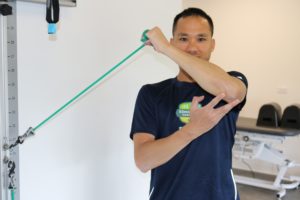
Definitions:
Tendinosis: Non-inflammatory changes to the structure or composition of a tendon. These changes often result from repetitive micro-traumas or failure of the tissue to heal following a tendon injury. Or it can be a normal finding of a tendon that has responded to repeated loads over a period of time. Tendinosis may or may not be symptomatic.
Impingement: is a condition where your shoulder rotator cuff tendons are intermittently compressed against an arch of bone and ligaments during shoulder movements. This may cause injury to the shoulder tendons and bursa over time, resulting in painful shoulder movements.
During the 2008 Summer Olympic Games, a study was performed on the United States Olympic Swim Team. The purpose of the study was to determine the prevalence of shoulder pain and pathology among the athletes just prior to the Games. The results were interesting:
66% reported shoulder pain
73% had biceps tendinosis (or “wear and repair” of their biceps tendon)
96% had rotator cuff tendinosis
83% demonstrated subacromial impingement
Shoulder laxity is a common finding among swimmers and the findings of tendinosis and subacromial impingement are very common in overhead athletes (tennis, badminton, squash, baseball players) but these findings can be asymptomatic. However, what is surprising is that two-thirds of these athletes entered the Games with pain!
One common finding among overhead athletes is shoulder lateral/outward rotation weakness and atrophy of one of the rotator cuff muscles called the infraspinatus. This muscle helps the other rotator cuff muscles in stabilizing our highly mobile shoulder joint and rotates our arm outwards. It is much weaker than the subscapularis muscle which rotates the arm inwards. Which is why the backhand stroke in racquet sports is always weaker than the forehand stroke.
In a study of professional female tennis players, 58% demonstrated infraspinatus atrophy in those ranked in the top 100 in the world while 40% had atrophy in those ranked 100 or lower in the standings. In other words, the more elite the player, the greater the infraspinatus atrophy. Tennis players because of the repeated overhead serving motion, tend to demonstrate a greater amount of shoulder outward rotation range of motion, a decreased amount of inward rotation, reduced outward rotation strength, a slower activation of the shoulder outward rotators, a reduced subacromial space resulting in impingement signs, and a greater imbalance between their inward and outward rotation strength. In other words, the more they play, the greater the imbalance of their shoulder function.
Therefore, the overall evidence regardless of the overhead sport is clear: in athletes with shoulder pain, these imbalances are greater than those without pain. Furthermore, if rehabilitation of these athletes focused on improving their outward rotation strength, thereby reducing their imbalances, the outcomes are far better than cortisone injections alone or surgery. In other words, the weakness of shoulder outward rotation is not merely correlative but appears to be the cause of the majority of these athletes’ pain.
 This therefore has great implications for the rehabilitation of overhead athletes with shoulder pain. These shoulder strength imbalances should be assessed and then a progressive and targeted strengthening program to address these imbalances are vital for both the short term (pain relief) and long term goals of the athlete (longevity and success in the sport).
This therefore has great implications for the rehabilitation of overhead athletes with shoulder pain. These shoulder strength imbalances should be assessed and then a progressive and targeted strengthening program to address these imbalances are vital for both the short term (pain relief) and long term goals of the athlete (longevity and success in the sport).
If you are an overhead athlete and if you are struggling with shoulder pain, it is best not to ignore the problem. Rest will reduce your pain in the short-term; however, symptoms will inevitably return once you return to playing if there is an underlying weakness in your rotator cuff muscles. Have your shoulder assessed!
